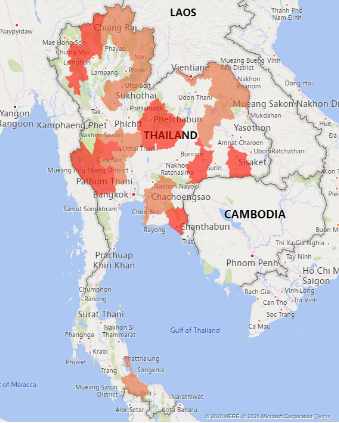ประเทศไทยเริ่มมีฝนตกน้อยกว่าปกติต่อเนื่องมาตั้งแต่ช่วงฤดูฝนปี 2561 (พฤษภาคม-ตุลาคม 2561) ซึ่งมีฝนตกเฉลี่ยน้อยกว่าปกติประมาณ 62 มิลลิเมตร หรือน้อยกว่าปกติประมาณ 5% โดยเกิดฝนตกน้อยกว่าปกติมากเป็นบริเวณกว้างในพื้นที่ตอนกลางของประเทศ ครอบคลุมทั้งภาคเหนือ ภาคกลาง ภาคตะวันออกเฉียงเหนือ และภาคตะวันออก รวมถึงในบางพื้นที่ของภาคใต้ แต่ทั้งนี้บริเวณชายขอบของประเทศกลับมีฝนตกมากกว่าปกติค่อนข้างมากในหลายพื้นที่โดยเฉพาะบริเวณตอนบนของภาคเหนือและด้านตะวันออกของภาคตะวันออกเฉียงเหนือ ต่อมาในช่วงฤดูแล้งปี 2561/2562 (พฤศจิกายน 2561-เมษายน 2562) ซึ่งเป็นช่วงที่ฝนตกน้อยเป็นปกติ แต่กลับพบว่าฝนที่ตกน้อยอยู่แล้วกลับน้อยลงไปอีก ครอบคลุมพื้นที่ตอนบนของ
ประเทศทั้งภาคเหนือ ภาคตะวันออกเฉียงเหนือ ภาคกลาง และภาคตะวันออก โดยเฉพาะอย่างยิ่งบริเวณภาคใต้ตั้งแต่จังหวัดสุราษฎร์ธานีลงไปที่มีฝนตกน้อยกว่าปกติค่อนข้างมากแม้จะอยู่ในช่วงฤดูฝนของภาค มีเพียงภาคใต้ตอนบนเท่านั้นที่มีฝนตกมากกว่าปกติเป็นบริเวณกว้าง ทั้งนี้ปริมาณฝนเฉลี่ยทั้งประเทศตลอดฤดูแล้งน้อยกว่าปกติประมาณ 66 มิลลิเมตร หรือน้อยกว่าประมาณ 24% และเมื่อเข้าสู่ฤดูฝนปี 2562 (พฤษภาคม-ตุลาคม 2562) พื้นที่ส่วนใหญ่ของประเทศยังคงมีฝนตกน้อยต่อเนื่อง มีเพียงบางพื้นที่ของภาคใต้ตอนล่างและบางพื้นที่ทางด้านตะวันออกของภาคตะวันออกเฉียงเหนือเท่านั้นที่มีฝนตกมากกว่าปกติ โดยปริมาณฝนเฉลี่ยตลอดฤดูฝนน้อยกว่าปกติประมาณ 151 มิลลิเมตร หรือน้อยกว่าประมาณ 13% ซึ่ง
สภาวะฝนแล้งดังกล่าว ส่วนหนึ่งเกิดจากการได้รับอิทธิพลจากปรากฎการณ์เอลนีโญกำลังอ่อน ซึ่งเกิดขึ้นตั้งแต่ประมาณช่วงเดือนตุลาคมปี 2561 ต่อเนื่องมาจนถึงช่วงกลางปี 2562 ต่อมาเมื่อเข้าสู่ฤดูแล้งปี 2562/2563 (พฤศจิกายน 2562-เมษายน 2563) สถานการณ์ฝนยังคงตกน้อยต่อเนื่องในเกือบทุกพื้นที่ของประเทศ มีเพียงบางพื้นที่ของภาคตะวันออก ภาคเหนือและภาคตะวันออกเฉียงเหนือเท่านั้นที่มีฝนตกมากกว่าปกติเป็นหย่อมเล็ก ๆ และจะเห็นได้ว่าภาคใต้มีฝนตกน้อยกว่าปกติค่อนข้างมากทั้งภาค แม้จะอยู่ในช่วงฤดูฝนของภาค ทั้งนี้ปริมาณฝนเฉลี่ยตลอดฤดูน้อยกว่าปกติประมาณ 106 มิลลิเมตร หรือน้อยกว่าประมาณ 38% ซึ่งสถานการณ์ฝนตกน้อยต่อเนื่องยาวนานในครั้งนี้ ส่งผลทำให้เกิดภัยแล้งในหลายพื้นที่
Thailand has experienced less rain since the rainy season of 2018 (May-October 2018), with an average rainfall volume of about 62 millimeters less than normal, or about 5% less than normal. A lot less rain than usual occurred in a wide area of the central part of the country covering the north, central, northeast and east regions including some areas of the south region. However, the border area of the country had quite a lot of rain more than usual in many areas, especially in the upper part of the north and east of the northeast. Later, during the dry season of 2018/2019 (November 2018-April 2019), which was a period of little rain normally there was even less rain than usual in the upper part of the country covering the north, northeast, central and east regions. During
these same months, in the south region from Surat Thani Province down to the border of the south, there was quite a lot less rain although it was the rainy season of this region. Only the upper southern region had more rainfall than usual covering wide area. The average rainfall of the entire country throughout the dry season was about 66 millimeters less than normal, or about 24% less. When entering the rainy season of 2019 (May - October 2019), most areas of the country still had little rain continuously. There were only some parts of the lower southern region and some parts on the east of the northeast region that had more rain than usual. The average rainfall during the rainy season was about 151 millimeters less than normal or about 13% less. Such drought conditions
were partly due to the influence of weak Elnino which occurred from around October 2018 continuously until mid-year 2019. When entering the dry season of 2019/2020 (November 2019-April 2020), less rain situation continued in almost all areas of the country. There were only some parts of the east, north and northeast regions that had more rain than normal in small area. The south region had quite a lot less rain than normal throughout the region even if it was the rainy season of the region, the average rainfall volume throughout the season was about 106 millimeters less than normal, or about 38% less. This long period of low rainfall situation had resulted in drought in many areas.
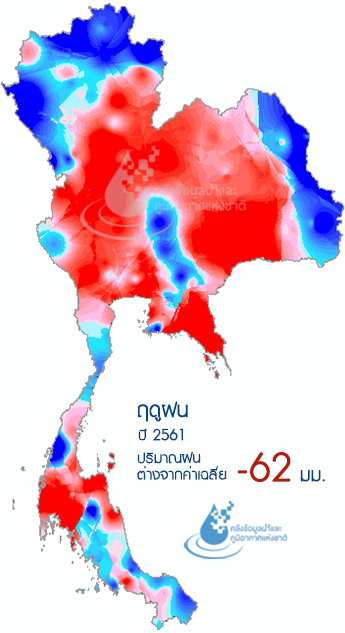
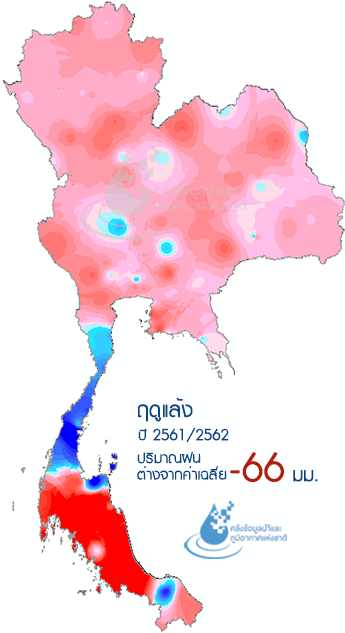
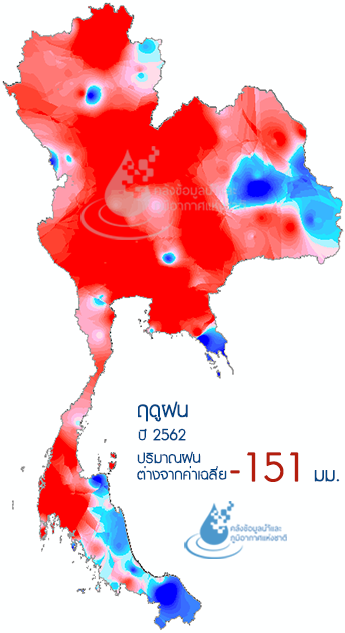
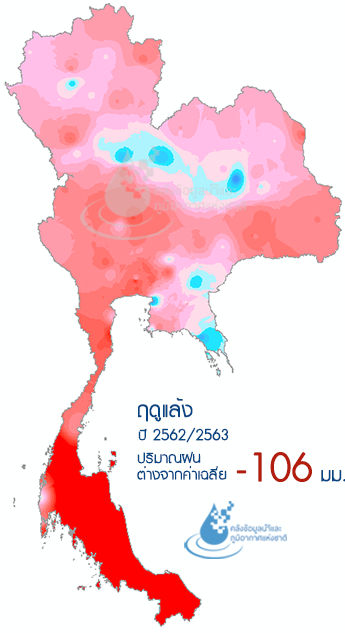

จากการที่ประเทศไทยมีฝนตกน้อยกว่าปกติในหลายพื้นที่ของประเทศต่อเนื่องเป็นระยะเวลายาวนาน ส่งผลทำให้มีปริมาณน้ำไหลลงเขื่อนค่อนข้างน้อย โดยตลอดปี 2562 เขื่อนขนาดใหญ่ทั้ง 35 แห่งทั่งประเทศมีปริมาณน้ำไหลลงเขื่อนสะสมเพียง 29,354 ล้านลูกบาศก์เมตร เท่านั้น แต่กลับมีการระบายน้ำออกไปมากกว่าน้ำที่ไหลเข้าเขื่อน ซึ่งหมายถึงมีการนำน้ำต้นทุนของปีก่อนหน้าออกมาใช้งานนั่นเอง และเมื่อวิเคราะห์ข้อมูลเป็นรายเขื่อนจะเห็นได้ว่าปี2562 มีเขื่อนที่ระบายน้ำแบบขาดทุนถึง 26 เขื่อน และมีหลายเขื่อนที่มีตัวเลข
ทำลายสถิติข้อมูลปริมาณน้ำไหลเข้าและปริมาณน้ำระบาย โดยเขื่อนที่การระบายน้ำมากกว่าปริมาณน้ำไหลเข้ามากที่สุดในรอบ 10 ปี หรือเรียกได้ว่าขาดทุนมากที่สุดในรอบ 10 ปี หรือหมายถึง การนำน้ำของปีก่อนหน้าออกมาใช้มากที่สุดในรอบ 10 ปี มีทั้งหมด 8 เขื่อน ได้แก่ เขื่อนคลองสียัด เขื่อนจุฬาภรณ์ เขื่อนนฤบดินทรจินดา เขื่อนบางพระ เขื่อนประแสร์ เขื่อนป่าสักชลสิทธิ์ เขื่อนแม่งัด และเขื่อนรัชชประภา ทั้งนี้เป็นเขื่อนที่ตั้งอยู่ในภาคตะวันออกถึง 4 เขื่อน โดยเฉพาะเขื่อนประแสร์ที่ปีนี้เกิดการขาดทุนเป็นครั้งแรกหลังจากที่เคยได้กำไรมาโดย
ตลอดตั้งแต่มีการสร้างเขื่อน นอกจากนี้ยังมีเขื่อนที่มีปริมาณน้ำไหลเข้าน้อยที่สุดในรอบ 10 ปี ได้แก่ เขื่อนกระเสียว เขื่อนคลองสียัด เขื่อนจุฬาภรณ์ เขื่อนทับเสลา เขื่อนนฤบดินทรจินดา เขื่อนบางพระ เขื่อนประแสร์ เขื่อนป่าสักชลสิทธิ์ แม่มอก เขื่อนลำแซะ เขื่อนลำพระเพลิง และเขื่อนอุบลรัตน์ โดยเฉพาะเขื่อนป่าสักชลสิทธิ์ เขื่อนอุบลรัตน์ และเขื่อนจุฬาภรณ์ ที่มีปริมาณน้ำไหลเข้าน้อยที่สุดนับตั้งแต่มีการสร้างเขื่อน ซึ่งส่งผลทำให้เขื่อนป่าสักชลสิทธิ์มีปริมาณน้ำกักเก็บคงเหลือและปริมาณน้ำระบายน้อยที่สุดตั้งแต่มีการสร้างเขื่อนอีกด้วย
Due to Thailand having less rain than usual in many areas of the country for a long time, the amount of water flowing into the reservoirs is therefore quite small. Throughout the year 2019, all 35 large reservoirs in the country had accumulated only 29,354 million cubic meters of water, but water was released more than the inflow of water. This means that water stored in the previous year was used. When analyzing data by dam, in the year 2019 there were 26 dams that released more water volume than inflow volume, and there were many dams with record breaking numbers of
water inflow and outflow. There were 8 dams whose outflow volume was greater than the inflow volume the most over the past decade, or the biggest loss in the last 10 years, which means the water stored in the previous year was released with the highest volume in 10 years: Klongsiyad Dam, Chulabhorn Dam, Narubordintharachinda Dam, Bangpra Dam, Prasae Dam, Pasakcholasit Dam, Maengad Dam and Rajjaprabha Dam. Four of these dams are in the east region, and in particular, the Prasae Dam suffered the water loss for the first time after having gained since the construction of the dam.
Moreover, there were dams that experienced the lowest inflow of water in 10 years: Kraseo Dam, Klongsiyad Dam, Chulabhorn Dam, Tabsalao Dam, Narubordintharachinda Dam, Bangpra Dam, Prasae Dam, Pasakcholasit Dam, Maemok Dam, Lamsae Dam, Lampraplerng Dam and Ubolratana Dam. Especially, Pasakcholasit Dam, Ubolratana Dam and Chulabhorn Dam had the lowest inflow of water since the construction of these dams, and this resulted in the Pasakcholasit Dam having the lowest volume of water stored and released since the dam was built.
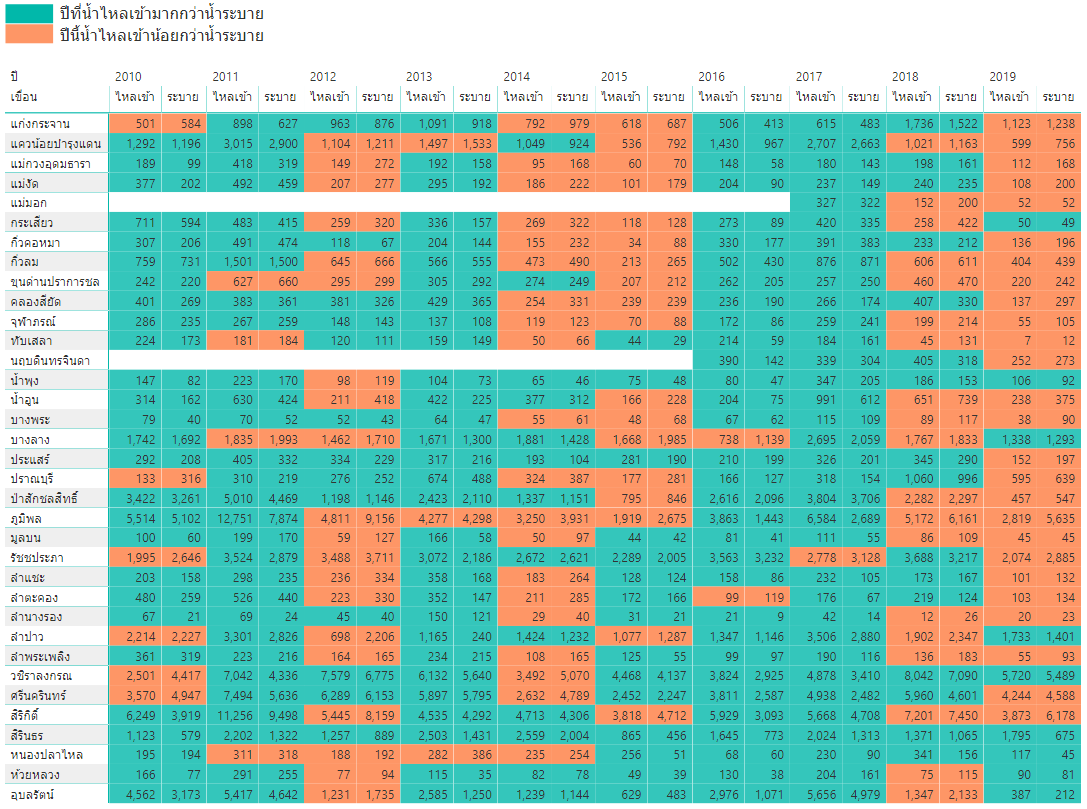
เมื่อน้ำไหลลงเขื่อนมีค่อนข้างน้อย ประกอบกับมีการระบายน้ำขาดทุนเป็นจำนวนมากหลายเขื่อน ส่งผลทำให้มีน้ำกักเก็บคงเหลือเพื่อเป็นต้นทุนในช่วงฤดูแล้งปี 2562/2563 เพียง 47,400 ล้านลูกบาศก์เมตร เป็นน้ำใช้การได้จริงเพียง 23,858 ล้าน
ลูกบาศก์เมตร ซึ่งน้อยกว่าฤดูแล้งของปีอื่น ๆ เมื่อเทียบกับข้อมูลย้อนหลังในรอบ 10 ปี แต่มากกว่าฤดูแล้งปี 2557/2558 และฤดูแล้งปี 2558/2559 และเนื่องจากมีการระบายน้ำออกไปใช้ในระหว่างฤดูค่อนข้างมากทำให้เมื่อถึงวันสิ้นฤดู
แล้งปี2562/2563 (30 เมษายน 2563) ปริมาณน้ำกักเก็บทั้งประเทศลดลงเหลือเพียง 13,834 ล้านลูกบาศก์เมตร เป็นน้ำใช้การได้จริง 10,288 ล้านลูกบาศก์เมตร ซึ่งเป็นปริมาณน้ำคงเหลือที่น้อยกว่าทุกฤดูแล้ง รองจากฤดูแล้งปี 2558/2559
Because of the low inflow and high water loss from the release at many dams, amount of water retained in water storage for the dry season of year 2019/2020 was 47,400 million cubic meters and only 23,858 million cubic meters of water was available for use.
This water storage volume was less than the dry season of other years when comparing the past 10 years data, but more than the dry season of 2014/2015 and 2015/2016. Due to quite a lot of water being released during the season, at the end of the dry season of
2019/2020 (30 April 2020), the country's total water storage volume was reduced to just 13,834 million cubic meters with 10,288 million cubic meters of usable water. It was the second lowest water storage volume after the dry season 2015/2016.
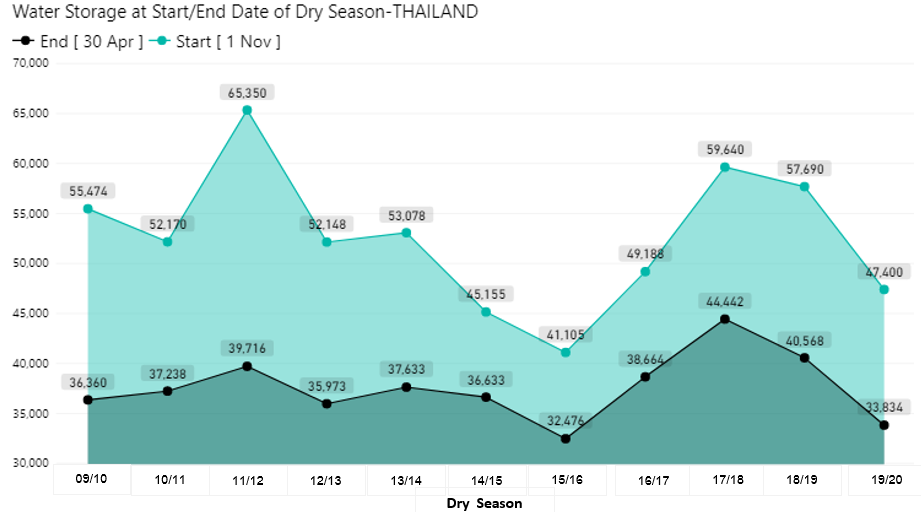
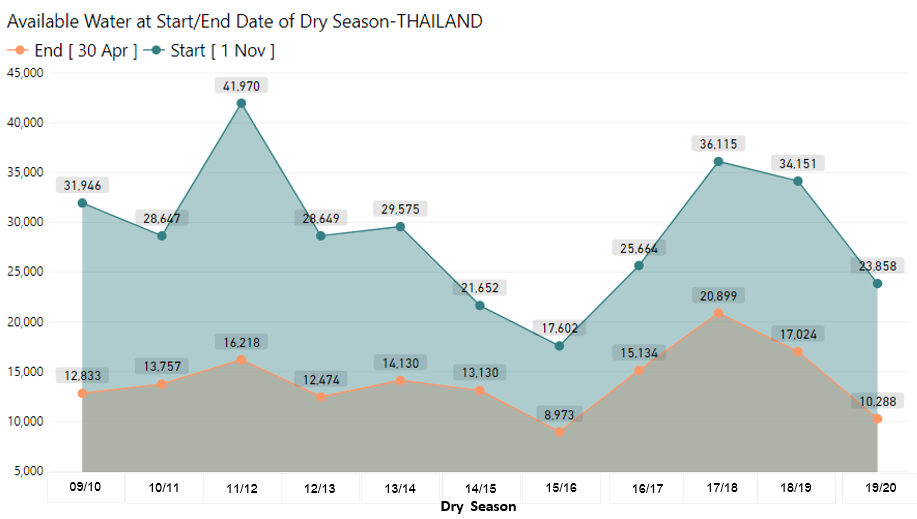
ถึงแม้น้ำในเขื่อนจะมีเหลืออยู่น้อยแต่การเพาะปลูกพืชในช่วงฤดูแล้งยังคงเกินแผนที่วางไว้ จากรายงานแผน/ผล การเพาะปลูกพืชในช่วงฤดูแล้งปี 2562/2563 ของกรมชลประทานเมื่อวันที่ 29 เมษายน 2563 จะเห็นได้ว่าช่วงฤดูแล้งปี 2562/2563 กรมชลประทานได้วางแผนการเพาะปลูกพืชช่วงฤดูแล้งทั้งประเทศไว้ทั้งสิ้น 2.83 ล้านไร่ แต่มีการเพาะปลูกจริง
4.75 ล้านไร่ ซึ่งเกินจากแผนไปถึง 1.92 ล้านไร่ หรือเกินแผนไปถึง 67.68% ทั้งนี้มีการปลูกข้าวนาปรังเกินแผนไป 1.9 ล้านไร่ หรือประมาณ 82.26% รวมถึงมีการเพาะปลูกพืชไร่-พืชผักเกินจากแผนไปกว่า 20,000 ไร่ หรือประมาณ 3.05% หากพิจารณาเป็นรายภาค พบว่า ภาคเหนือ ภาคตะวันออกเฉียงเหนือและภาคตะวันออก มีการเพาะปลูกพืชเกินจากแผนที่วางไว้ โดย
ทั้ง 3 ภาคมีการเพาะปลูกข้าวนาปรังเกินจากแผนทุกภาค โดยเฉพาะภาคเหนือที่มีการเพาะปลูกเกินแผนทั้งในส่วนของข้าวนาปรังและพืชไร่-พืชผัก สำหรับลุ่มน้ำเจ้าพระยาที่ฤดูแล้งนี้กรมชลประทานได้ประกาศให้งดทำนาปรัง แต่ยังคงพบเกษตรกรทำการเพาะปลูกข้าวนาปรังไปถึง 1.98 ล้านไร่ รวมถึงมีการเพาะปลูกพืชไร่-พืชผักอีกกว่า 50,000 ไร่
Although the dams had low water storage volume, crop planting during dry season was still beyond the plan. The Royal Irrigation Department (RID) reported the plan and result of crop planting during the dry season of 2019/2020 on 29 April 2020 that RID had planned to cultivate 2.83 million rai of crops in the entire country, but the actual crop planting area was 4.75 million rai, which It was 1.92 million rai more
than planned, or 67.68% beyond the plan. This includes the off-season paddy plantation which was 1.9 million rai beyond the plan or about 82.26%, and field-crops/vegetables cultivation, which was more than 20,000 rai beyond the plan or about 3.05%. When analyzing by region, it showed that in the north, northeast and east regions, there was more crop planting area than planned in which all 3 regions
had an excess of off-season paddy plantation, especially in the north region that had more crop planting area beyond the plan for both off-season rice crop and field-crops/vegetables. For the Chao Phraya River Basin, in this dry season, RID announced the suspension of off-season paddy farming but farmers still cultivated 1.98 million rai of off-season rice and more than 50,000 rai of field-crops/vegetables.
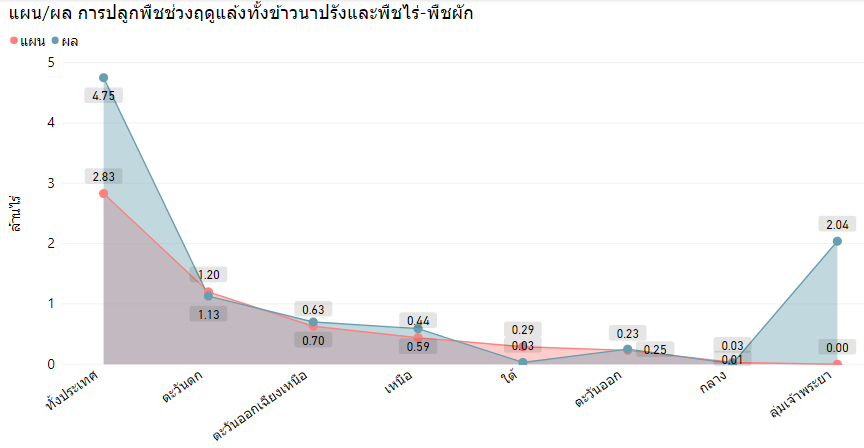
นอกจากนี้ ผลจากการที่มีฝนตกน้อยและน้ำในเขื่อนเหลือน้อย ยังส่งผลกระทบต่อสถานการณ์น้ำเค็มรุกในแม่น้ำเจ้าพระยาโดยในช่วงฤดูแล้งปี 2562/2563 เกิดสถานการณ์น้ำเค็มรุกล้ำลำน้ำจนส่งผลกระทบต่อผู้ใช้น้ำในหลายภาคส่วน โดยเฉพาะการสูบน้ำดิบเพื่อนำไปผลิตน้ำประปา โดยที่สถานีสูบน้ำดิบสำแล อ.เมือง จ.ปทุมธานี ซึ่งเป็นสถานีสูบน้ำดิบสำคัญที่น้ำดิบจากจุดดังกล่าวจะถูกนำไปผลิตน้ำประปาสำหรับผู้ใช้น้ำในเขตกรุงเทพมหานครและปริมณฑล โดยบริเวณนี้เริ่มได้รับผลกระทบจากสถานการณ์น้ำเค็มรุกตั้งแต่ช่วงต้นเดือนธันวาคม 2562 หลังจากนั้นก็เกิด
สถานการณ์เป็นระยะ ๆ ตลอดฤดู โดยความเค็มที่วัดได้มีทั้งที่เกิน 0.25 กรัม/ลิตร และเกิน 0.50 กรัมต่อลิตร ที่เกิดสลับกันไป ซึ่งหากค่าความเค็มที่วัดได้เกิน 0.25 กรัมต่อลิตร จะต้องมีการเฝ้าระวังการผลิตน้ำประปา เนื่องจากจะทำให้ประปามีรสกร่อยและเป็นอันตรายต่อผู้ใช้น้ำบางกลุ่ม และถ้าค่าความเค็มเกิน 0.50 กรัม/ลิตร จะต้องหยุดสูบน้ำดิบ เนื่องจากเป็นความเค็มที่เกินมาตรฐานน้ำดิบเพื่อการผลิตน้ำประปา โดยในช่วงฤดูแล้งนี้ค่าความเค็มสูงสุดที่วัดได้ อยู่ที่ 2.06 กรัมต่อลิตร ในวันที่ 28 ธันวาคม 2562 ซึ่งถือเป็นค่าความเค็มที่ค่อนข้างสูง
นอกจากนี้สถานการณ์น้ำเค็มได้รุกสูงขึ้นไปถึงบริเวณจุดตรวจวัดคุณภาพน้ำที่วัดไผ่ล้อม อ.สามโคก จ.ปทุมธานี ในช่วงปลายเดือนธันวาคม 2562 กลางเดือนกุมภาพันธ์ 2563 และ ปลายเดือนเมษายน 2563 ซึ่งส่วนใหญ่ความเค็มที่วัดได้มีค่าเกิน 0.25 กรัมต่อลิตร และมีค่าที่วัดได้เกิน 0.50 กรัมต่อลิตร เกิดขึ้นเพียงครั้งเดียวในวันที่ 28 ธันวาคม 2562 ที่วัดได้ 0.51 กรัมต่อลิตร ซึ่งเป็นค่าสูงสุดที่วัดได้ในช่วงฤดูแล้ง 2562/2563 ของจุดตรวจวัดนี้ และเป็นวันเดียวกันกับที่เกิดค่าความเค็มสูงสุดที่สถานีสำแล
Moreover, low rainfall and low water storage volume led to salinity intrusion situation in the Chao Phraya River during the dry season of 2019/2020 which affected water users in several sectors, especially the tap water production. The raw water pumping station at Samlae, which is located in Muang District of Pathumthani Province, is the main station that pumps raw water from that point to produce tap water for water users in Bangkok and suburbs. This area had been affected by saltwater intrusion situation since the early of December 2019, after which the situation occurred periodically
throughout the season, with the measured salinity sometimes in excess of 0.25 grams/liter (g/l) and 0.50 g/l alternately. If the salinity value is greater than 0.25 g/l, the tap water production must be monitored, because it will make the water tap taste brackish and harmful to some water users. If the salinity value is greater than 0.50 g/l, the pumping of raw water must be stopped because it is the salinity level that exceeds the raw water standard for tap water production. During this dry season, the highest salinity value was 2.06 g/l on 28 December 2019, which was considered
a relatively high salinity. In addition, the saltwater situation had advanced to the upper area of the river at Wat Phailom water quality station located in Samkok District, Pathumthani Province, in the end of December 2019, mid February 2020 and the end of April 2020. Most of the measured salinity values exceeded 0.25 g/l and one measured value exceeding 0.50 g/l that occurred only once on 28 December 2019 at 0.51 g/l. This was the highest measurement during the dry season 2019/2020 of this checkpoint, and it was the same day that the highest salinity was observed at Samlae Station.
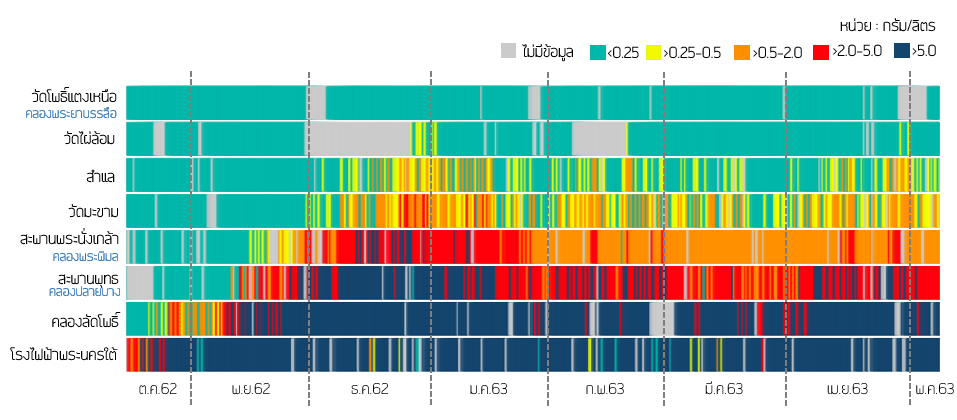
ทั้งนี้ กรมป้องกันและบรรเทาสาธารณภัย กระทรวงมหาดไทย ได้รายงานสถานการณ์ภัยแล้งตั้งแต่วันที่ 17 ตุลาคม 2562 ถึงวันที่ 30 เมษายน 2563 มีจังหวัดที่ประกาศเขตการให้ความช่วยเหลือผู้ประสบภัยพิบัติกรณี
ฉุกเฉิน (ภัยแล้ง) ทั้งหมด 27 จังหวัด 157 อําเภอ 832 ตําบล 5 เทศบาล 7,242 หมู่บ้าน/ชุมชน ได้แก่ จังหวัดเชียงราย เชียงใหม่ พะเยา น่าน อุตรดิตถ์ สุโขทัย เพชรบูรณ์ หนองคาย บึงกาฬ นครพนม สกลนคร กาฬสินธุ์
มหาสารคาม นครราชสีมา บุรีรัมย์ ชัยภูมิ ศรีสะเกษ นครสวรรค์ อุทัยธานี ชัยนาท สุพรรณบุรี กาญจนบุรี ฉะเชิงเทรา ปราจีนบุรี จันทบุรี ชลบุรี และจังหวัดสงขลา
In this regard, the Department of Disaster Prevention and Mitigation reported drought disaster situations for period from 17 October 2019 to 30 April 2020. There was a total of 27 provinces covering 157 districts, 832 sub-districts,
5 municipalities, and 7,242 villages/communities that declared an emergency disaster relief area, namely Chiangrai, Chiangmai, Payao, Nan, Utaradit, Sukothai, Petchabun, Nongkhai, Bungkan, Nakornpanom, Sakonnakhon, Kalasin,
Mahasarakham, Nakhonratchasima, Burirum, Chaiyapum, Sisaket, Nakhonsawan, Uthaithani, Chainat, Supanburi, Karnchanaburi, Chacherngsao, Prachinburi, Chanthaburi, Chonburi and Songkla.
